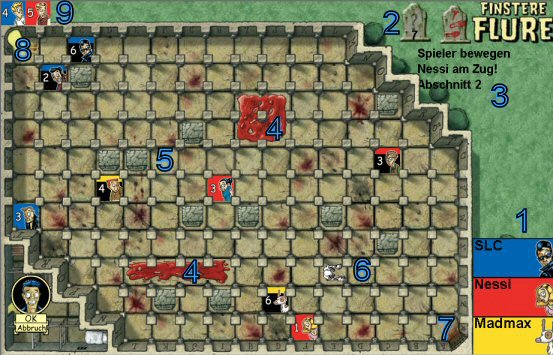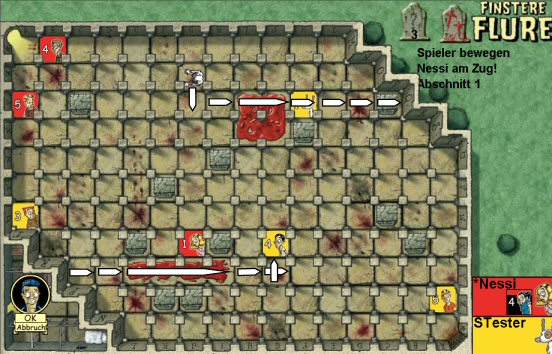Finstere Flure
Preparazione del gioco
With /join 2-7 players can join the game. The game begins with /start. Alternatively, you can use the game management.
Il gioco
Each player tries his game pieces to navigate safely through the dark corridors of Lord Fieso's terrible fortress. The aim is to avoid Furunculus, the fearsome court monster, as much as possible and at the same time put him on the trail of the other players. Whoever reaches the safe exit first with enough figures will be greeted by the fascinating fairy Fabula.
Tavolo di gioco

- Stato dei giocatori
- Monster Run Cards
- Indicatore di Stato
- Blood Pools
- Stone blocks
- Monsters
- Entrance field
- Target field
- Players who have already reached the goal < /ol>
- You always move horizontally and/or vertically - diagonally is not allowed.
- You can jump over other people's pieces However, the occupied field is counted
- The turn must end on a free field.
- The monster may not be jumped over.
- Stone blocks lying in the way are pushed away if that The field behind it is free. If not, pushing is not possible
- If you step on a pool of blood, you slide straight ahead to the first space behind the pool without using up any points.
- pushes If a player places a stone block on a pool of blood, it slides straight like a figure onto the field behind the pool. If there is a figure there, the stone remains at the end of the pool of blood.
- A hit card is never drawn as the first monster card.
- If a stone block is pushed onto the start or destination field, it becomes immediately removed
- All fields that can be reached within three steps from the entrance or exit may not be occupied.
- Blood pools must only be reached after eight steps from the entrance and must not touch the edge of the field or other pools of blood.
Svolgimento
All players try to move their pawns across the playing field to the exit (target field). move without being caught by the monster.
Each player has four tokens at the start (only three for 5-7 players), each of which has a colored and a black side . The front and back of each token always add up to 7.
The game consists of two sections: Section 1 ends as soon as seven of the eight monster cards have been revealed. The eighth card is no longer played. Figures that are eaten by the monster within the first section are thrown out, but can be used again on the starting field. Then the cards are reshuffled and section 2 begins. Now the monster shows no mercy: anyone who runs into his arms is irredeemably lost and is taken out of the game.
< span>Player moves
Each player takes turns moving one of his game pieces; Each token is moved exactly once per round. The exception is the first round, where only two pieces are used. A token can always be moved as far as its visible number indicates - then it is turned over for the next round. This also applies if a stone has been moved 0 spaces.
To move a figure, first mark the corresponding figure (click on the number for the figures outside the field) and then click the path field by field. In the case of pools of blood, each field must be selected individually.

If you are lost or would like to go a different way, you can "cancel" your move.
Otherwise you click "OK" to complete your turn.
These apply The following moving rules:
To leave the portico, you must reach the target space in the top left and still have one movement point left to exit. Figures that were able to move out of there are safe from the monster.
Monster moves
At the beginning, the monster always stands on the target space with the direction of movement to the right. How far the monster runs is determined by the monster cards, one of which is revealed in each round. There are eight monster cards per section with the following values: 5 - 7 - 7 - 8 - 8 - 10 - X - XX. The numbers indicate the movement range of the monster. The two cards X and XX are one- and two-hit cards, respectively. If these are drawn, the monster runs until it catches one or two players - but a maximum of 20 spaces.

The monster card display always shows the one currently drawn on the right Map displayed. On the left you can see the stack of remaining monster cards.
Before the monster takes the first step, it first looks to the right, left and straight ahead; If he doesn't see anyone, he takes a step forward and looks in all three directions again (never backwards!). In this way it runs forward until it has reached its number of points or has been able to eat one or two figures (hit cards). At the end of its turn it looks again and turns again when it sees a figure. If it sees a character on the way, it turns in that direction and runs towards it. If it sees several figures at the same time, it runs to the one that is closest to it. If several figures are close together, the monster is confused and continues in its chosen direction.
If it hits a stone block, it pushes it, along with everything behind it, in front of it here. If the game pieces are pushed against a wall, they are considered eaten. Stone blocks smash against the wall and are thrown out of play. If the monster itself hits a wall, it disappears there and comes out again at the same letter on the opposite side.
If it runs into a pool of blood, it slides, just like the playing figures , straight ahead. While sliding, it doesn't see any figures to the right or left, so it doesn't change direction on the pool of blood.
Example of one Monster turn:

Let's assume that for this turn the 10 card would be drawn: before the monster starts running, it looks and sees the red 1 to its left. So it turns left and runs downwards. But already on the first field it sees the yellow 1 on the left. Since the yellow 1 is closer, it turns left again and slides over the pool of blood. Since it cannot look to the right and left while sliding, it does not notice the yellow 4 further down. It eats the yellow 1 and continues straight ahead. It pushes the stone block against the wall and crumbles it in the process. The monster itself runs through the wall at the letter Q and comes out at the Q on the opposite side. It doesn't see anything new and therefore continues straight ahead, slides over the pool of blood again, this time missing the red 1 as it slides, runs one more step behind the pool of blood and then stops because it has completed its ten steps. But it still sees the yellow 4 and turns up for the next round.
Fine del gioco
As soon as a If the player manages to navigate all but one character out of the colonnade (with 2-4 players, three characters, with 5-7 players, two characters), the end of the game is heralded. According to the DM rules that apply here, the current round is played to the end. The winner is the player who was able to save three figures. In the event of a tie, the winner is who saved their last playing figure first.
If there are no more figures on the playing field in the second half of the game, the game also ends. The winner is the player who was able to save the most game pieces first.
If the monster card stack was played through again in the second section down to the last card and no player was able to fulfill the victory conditions, it ends the game too. The player who was able to bring out the most game pieces first wins.
Special cases
Options
dm structure
The distribution of the corridor tiles (stones and pools of blood) is determined by the players. Starting with the starting player, each player in turn takes any hallway tile and places it on the field. The following applies:

